A History of Genetic Engineering
N.B. All images are 'thumbnailed'. Click on image to download full
version.
Genetic engineering is normally taken to mean recombinant DNA technology -- the
artificial addition, deletion or rearrangement of sequences of bases in DNA in order to
alter the observable form and function of an organism. However, genetic engineering is
sometimes referred to as biotechnology and biotechnologists have been quick to point out
that mankind has been doing biotechnology ever since the first farmers some 10,000 years
ago started to domesticate wild species by selecting seeds of wild plants for cultivation
or selectively breeding wild animals. In this history, therefore, we include any
artificial intervention in the reproductive process as well as some landmarks in the
development of genetics which has made genetic engineering possible. This will include
selection procedures old and new which could influence the genetic outcome of a
reproductive event, gene therapy and diagnosis as well as cloning, vegetative reproduction
and in vitro (test-tube) reproduction procedures.
For other timelines see:
http://www.whybiotech.com/index.asp?id2157
(plant biotechnology)
http://www.ncbiotech.org/biotech101/timeline.cfm
(general biotechnology)
circa 10,000 years ago
The beginnings of agriculture: selection of wild grasses and subsequent breeding in
cultivation to form the precursors of modern staples such as wheat, rice and maize. A
considerable practical knowledge was developed by breeders over the centuries and
selection procedures often achieved from a single wild species a huge difference in form
and function: e.g. the Great Dane and Chihuahua dog varieties from the wolf. Furthermore,
'unnatural' hybrids -- i.e. creating breeds across species barriers -- were made in
ancient times. For instance the mule, a cross between a jackass or male donkey and a mare
has been used as a pack animal in Europe for at least 3,000 years.
1627
Francis Bacon foretells genetic engineering and terminator technology.
Quotation from Bacon's 'New Atlantis'.
1859
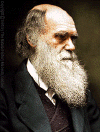
Charles Darwin published the first edition of The Origin of the Species which
amongst other things gives extensive information on the knowledge of breeding at that
time. Download The Origin of the Species from either of the two sites below:
http://www.literature.org/authors/darwin-charles/the-origin-of-species/
http://www.human-nature.com/download/darwin.html
(leads to Zip file)
1865
Gregor Mendel's publication of his discoveries with the breeding of peas which became
the foundation of modern genetics. MendelWeb -
Origins of classical genetics.
1866
Ernst Haeckel proposes that the cell nucleus is the bearer of an organism's heritable
characteristics.
1869
Friedrich Miescher discovers nuclein -- a major component of which is DNA -- in the
cell nucleus.
1875
Oscar Hertwig using microscopy observes sea urchin sperm entering the egg and the two
nuclei fusing.
1890
Birth of a rabbit from an embryo implanted in the uterus of a surrogate.
1900
Hugo de Vries, Carl Correns & Erich von Tschermak rediscover Mendel's principles.
1902
Walter Sutton & Theodor Boveri propose the chromosome theory of inheritance.
Archibald Garrod suggested from studies of alcaptonuria, a disease for which one
symptom is the appearance of a black pigment in the urine, that a defective gene gave rise
to a defective enzyme (a protein which is a biological catalyst in cell processes).
1910
T. H. Morgan demonstrated that the chromosomes are the concrete entities which carry
the genes. (Also Clavin Bridges, 1916)
1913
A.H. Sturtevant constructed a genetic map.
1927
H. J. Muller demonstrated that genetic mutation could be induced by X-rays.
1931

Barbara McClintock and Harriet Creighton demonstrate direct physical recombination by
examining maize chromosomes microscopically.
1941
George Beadle and E. L. Tatum pinned a gene defect down to a single step in a
biochemical pathway that would normally be carried out by an enzyme. They restored normal
growth to a mutant micro-organism by adding the missing enzyme.
1944
Oswald Avery demonstrates by experiments on transforming bacteria that of the three
polymers in the cell nucleus: DNA, RNA and protein it is the DNA which carries the genetic
information.
1949
Development of a technique for freezing and storing bovine sperm.
1951
Implantation of an embryo in a cow's uterus.
1952
Birth of a calf by artificial insemination (AI).
Cloning of frog embryo cells.
In-vitro (in the test-tube) regeneration of plants.
1953

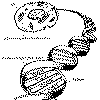 Artist's impression of DNA
Artist's impression of DNA
James Watson and Francis Crick using X-ray diffraction data for the structure of the
DNA molecule from Rosalind Franklin and Maurice Wilkins proposed the double helix
structure of DNA.
Human artificial insemination used for first time.
1954
Rabbit in vitro fertilisation (IVF).
1958
Matthew Meselson and Franklin Stahl demonstrated the semi-conservative replication of
DNA.
1961
Sidney Brenner, François Jacob & Matthew Meselson Discovered messenger RNA.
1962
Cloning of differentiated (adult) toad cells.
1966
Marshall Nirenberg & Har Gobind Khorana finished unravelling the genetic code.
late 1960s
Stewart Linn & Werner Arber discovered restriction enzymes in E. coli. These
enzymes known as endonucleases 'cut' DNA at specific sites determined by the adjacent base
sequences. Since then hundreds of these enzymes have been discovered in different
micro-organisms and together they comprise one of the most important tools in the genetic
engineer's toolbox. The property of restriction enzymes to create 'sticky ends' in the
'cut' DNA allows fragments of DNA of known properties and composition to be 'spliced' into
the DNA 'chain'.
1970
Plants regenerated from protoplasts (plant cells with cell wall removed).
1972
Paul Berg made the first recombinant DNA in vitro.
Mouse born from an embryo which had been stored frozen.
1973
Herbert Boyer & Stanley Cohen performed the first recombinant DNA cloning
experiment using restriction enzymes discovered only a few years before to insert DNA into
a plasmid and use the transgenic plasmid (a circular bacterial 'chromosome') to transform
bacteria.
Calf born from an embryo which had been stored frozen.
Identification of the Ti plasmid used for genetically engineering plants.
1975
February, the "Council of Asilomar", a conference in the USA at which the
"molecular bishops" met to discuss how the newly discovered and potentially very
dangerous recombinant DNA technology (genetic engineering) should proceed.
J. B. Gurdon and others: cloned frog keratinocytes (skin cells) survived to the
tadpole stage.
1976
Prenatal genetic diagnosis with the help of DNA.
1977
Walter Gilbert and Frederick Sanger worked out methods to determine the sequence of
bases in DNA.
 Autoradiogram of part of a sequencing
electrophoresis gel showing a lane for each of the four DNA bases A, C, G & T.
Autoradiogram of part of a sequencing
electrophoresis gel showing a lane for each of the four DNA bases A, C, G & T.
1977
Frederick Sanger determined the base sequence of an entire viral genome (f X174).
1977
Phillip Sharp, Richard Roberts, and others discovered interruptions (introns) in
genes.
1978
Birth of Louise Brown (25th July) -- the first 'test-tube' baby born from in
vitro fertilisation (IVF).
1979
Twin lambs born through artificial embryo splitting.
First production of insulin through genetic engineering.
1980
First transgenic (genetically modified) mouse.
1982
Giant mouse produced by transferring growth hormone genes from a rat.
Calf born after IVF.
1983
Kary Mullis, a biochemist invented the polymerasein reaction or polymerase chain reaction which
is a technique enabling scientists to reproduce bits of DNA faster than ever before.
(Mullis was awarded the Nobel Prize for this in 1993)
First transgenic plant (tobacco).
Richard Palmiter and Ralph Brinster placed the gene for human growth hormone in an
early mouse embryo. The resulting adult was double the normal size.
1984
Birth of a baby from an embryo which had been stored frozen.
Development of genetic fingerprinting, a technique that has greatly helped the
police force in finding and identifying criminals.
 An example of a young sheep-goat chimaera. (Image
courtesy of Dr Gary B. Anderson.)
An example of a young sheep-goat chimaera. (Image
courtesy of Dr Gary B. Anderson.)
Sheep-goat chimaera created, dubbed a 'geep'. Note patches of sheep's wool and goat's
hair. (Original paper: Fehilly, C. B., S. M. Willadsen, and E. M. Tucker. 1984.
Interspecific chimaerism between sheep and goat. Nature (Lond.) 307:634.)
1985
First transgenic domestic animal, a pig.
First transgenic plant produced which was resistant against a definite insect
species.
1986
Cloning of embryo cells from sheep.
1987
Transgenic mice produced whose milk had an artificially altered composition caused by
the expression of genes coding for sheep beta-lactoglobulin and human alpha-1-antitrypsin.
A series of transgenic mice produced carrying human genes.
A transgenic plant produced resistant to a particular kind of herbicide.
1988
Nancy Wexler, Michael Conneally and James Gusella located the Huntington disease gene
on human chromosome 4.
First transgenic plant producing a pharmaceutical.
Transgenic maize (corn) produced.
First animal patented: the Harvard University 'oncomouse', a transgenic mouse
genetically engineered to develop cancer.
1989

Publication (Science 254: 1281-1288) of data about the 'Beltsville pig', a transgenic
pig (named after the agricultural research station in Maryland USA) which suffered a range
of pathological conditions because it had a gene for human growth hormone.
1990
Lap-Chee Tsui, Francis Collins, and John Riordan found the gene that is responsible
for cystic fibrosis.
 Tracy with her two lambs.
Tracy with her two lambs.
Transgenic sheep 'Tracy' produced with the human gene for alpha-1-antitrypsin which
is expressed in the milk. The intention is to harvest the alpha-1-antitrypsin for the
treatment of human emphysema. Ian Wilmut and colleagues, Roslin Institute, Scotland.
James Watson and many others launched the Human Genome Project to map the
entire human genome and ultimately to determine its base sequence.
 Herman and his offspring
Herman and his offspring
Gene Pharming, Netherlands produce first transgenic bull, 'Herman'. (Herman was
killed on 3 April 2004 having developed arthritis)
1991
First gene therapy trials on humans.
First transgenic cows producing human lactoferrin in their milk (Gene Pharming,
NL). The intention is to harvest the lactoferrin for the treatment of septicaemia.
1992
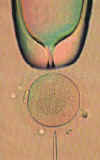 Micrograph of cell held in place by suction from above,
injection micropipette approaching from below.
Micrograph of cell held in place by suction from above,
injection micropipette approaching from below.
Introduction into IVF procedures of intra-cytoplasmic sperm injection (ICSI).
1994
Plant IVF -- maize (corn).
1994
 Transgenic tomatoes (left) contain a
softening inhibition gene.
Transgenic tomatoes (left) contain a
softening inhibition gene.
Transgenic tomatoes sold in the shops.
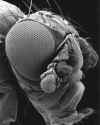 Scanning electron micrograph of Drosophila
head showing extra compound eye on right antenna.
Scanning electron micrograph of Drosophila
head showing extra compound eye on right antenna.
Walter Gehring and colleagues introduce expression of a single eye control gene in Drosophila
melanogaster (fruit fly) antennae, thus producing compound eyes on the antennae, and
show that the corresponding mouse eye control gene supports compound eye
development in Drosophila in the same way. Gehring Lab Home Page http://www.biozentrum.unibas.ch/gehring/index.html
1995
June, Paris: birth of first baby produced by the fertilisation of an ovum (egg cell)
with a spermatid (spermatozoa precursor) -- collaboration of Jacques Testart (INSERM) and
Jan Tesarik (American Hospital, Paris).
In May, Duke University Medical Centre (USA) researchers transplanted hearts from
genetically altered 'humanised' pigs into baboons.
1997
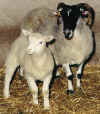 Dolly (left) and her Scottish Blackface surrogate
mother.
Dolly (left) and her Scottish Blackface surrogate
mother.
Ian Wilmut and colleagues, Roslin Institute, Scotland announced the birth of a lamb
(Dolly) cloned by nuclear transfer using an mammary cell from an adult sheep as nucleus
donor and an enucleate ovum as recipient. http://www.ri.bbsrc.ac.uk/public/cloning.html
March 2, Beaverton, Oregon, USA: cloning of 2 monkeys by embryo splitting.
A transgenic tobacco variety producing haemoglobin, a human blood protein.
December, birth of the first transgenic cloned sheep, 'Polly'. Foetal cells were
taken from Poll Dorset lambs, and the blood clotting factor IX gene inserted, cultured,
tested to see they had which cells had taken up the gene and only those cells used for
nuclear transfer cloning in the way Dolly was created.
http://www.ri.bbsrc.ac.uk/library/press/pn97-03.html
1998
March 3: 'Terminator technology' moved a step closer to the fields: US Patent No.
5,723,765, granted to Delta & Pine Land Co. an American cotton seed company and the
U.S. Department of Agriculture (USDA) on a technique that genetically-disables a seed's
capacity to germinate when planted again.
April, a UK supermarket chain bans use of GMOs in its products, a move which is
over the following 18 months is followed by the other UK supermarket chains.
May, Roslin Institute, Scotland -- discovery of premature ageing of cells in Dolly
the cloned sheep.
US scientist clones one of his own cells in a cow's egg.
December, Lee Bo-yon of Kyunghee University, South Korea claims to have been the
first to carry out human cloning by nuclear transfer. The fusion product was last seen
dividing into four cells before the operation was aborted.
1999
September, first publicly reported patient death in a gene therapy trial caused by
the gene therapy itself.
2000
Monday 26 June: The leaders of the publicly sponsored Human Genome Project (HGP) and
Craig Venter who leads the parallel private initiative of the company Celera Genomics
announce completion of the first draft of the human genome.
First gene therapy successes:
1) April, successful treatment of SCID in France
2) August, successful treatment of heart muscle blood supply using vascular
endothelial growth factor gene by Jeffrey Isner and colleagues at Tufts University,
Boston, USA
http://www.guardianunlimited.co.uk/Archive/Article/0,4273,4056330,00.html
May, widespread contamination of the UK oilseed rape (canola) crop by GM oilseed
rape contaminated seed imported from Canada by Advanta.
29 August: birth of Adam Nash, wrongly hailed in the press as world's first
'designer' baby. In fact he was born after IVF following which pre-implantation genetic
diagnosis of the embryos was carried out to ensure that they did not carry the genes for
Fanconi's anaemia, a disease suffered by his sister Molly. After his birth, his umbilical
cells were used in the successful tissue transplantation treatment of his sister.
2 October: World's first germ-line genetically modified monkey (rhesus) born in
Oregon USA.
 How ANDi was created in vitro
How ANDi was created in vitro
2 October: Birth of first genetically modified primate, a rhesus monkey named ANDi
(inserted DNA backwards) and containing a fluorescent marker gene from a jellyfish, at
Oregon Regional Primate Research Centre, USA (news released on 12 January 2001). 224 eggs
were injected with the gene. On fertilisation these yielded 40 viable embryos from which 5
pregnancies resulted. Of 3 monkeys born live tests show that only ANDi carries the gene,
although it is not being expressed.
2001
22 January: UK Parliament passes a regulation believed to allow the cloning
of human embryos for the purposes of research into serious disease. Embryos may be
experimented on only up to their 14th day of life.
11 February: Publication in the journals Nature and Science of
the first draft of the human genome estimated to be between 26,000 and 40,000 genes.
5 May: World's first genetically modified humans. US scientists announce that
babies have been born carrying the DNA of three parents: two women and a man. The babies
were the result of ooplasmic transplantation -- effectively adding cytoplasm from a donor
woman's egg to that surrounding the nucleus of an infertile woman's egg.
26 November: First human 'embryo' cloned. Advanced Cell Technologies USA used
somatic adult cell nuclear transfer ('Dolly method') to create a clone which developed to
six cells before dying.
2002
 "cc" (carbon copy)
"cc" (carbon copy)
14 February: News released of worlds first cloned cat.
2004
Seoul National University in South Korea: first human embryos created that were true
clones of the sixteen women who provided the cells to make them.
N.B. All images are 'thumbnailed'. Click on image to download full version.
To Ifgene Home Page
To Student Help Desk
Source URL of this page: history.htm
Page last updated 23 April 2005.












